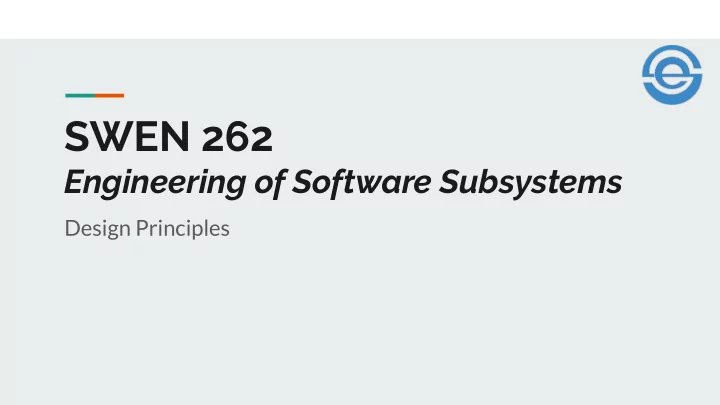

SWEN 262 Engineering of Software Subsystems Design Principles
Object Oriented Principles (Review) Classes ● A class is a blueprint that defines the state (data) and behavior (methods) that belong to some class of thing. ○ It is like a recipe; a set of instructions for building objects. ○ Objects (Identity) ● An object is a unique, identifiable instance of a specific class. ○ Each object has its own copy of the state and behavior defined by the class. ○ Encapsulation ● An object encapsulates its state and behavior, holding it together in one place. ○ It protects access to data and methods using access modifiers. ○ Inheritance ● One class (the child ) inherits the accessible state and behavior from another class (the parent ). ○ Objects of the child class include the state and behavior defined by the parent class. ○ Polymorphism ● An instance of a child class can be treated as though it is an instance of the parent class. ○ What appears to be a single method at runtime may be one of many implementations (overriding). ○
SOLID The SOLID principles were first described by Bob Martin. S ingle Responsibility Principle O pen-closed Principle L iskov Substitution Principle Uncle Bob I nterface Segregation Principle D ependency Inversion Principle
GRASP ● Controller The GRASP principles were ● Creator first described by Craig Larman G because acronyms are cool. eneral ● Indirection R ● Information Expert esponsibility A ● High Cohesion assignment ● Low Coupling S oftware ● Polymorphism P ● Protected Variations patterns and/or principles ● Pure Fabrication
The Waiter Waiter Diner Wallet -payments: double -myWallet: Wallet -double: totalMoney +eat() +deduct(amount:double) +serve(diner:Diner) + getWallet(): Wallet + getTotalMoney():double Consider the design of this system. Where is the unintended coupling? Are there any other public class Waiter { negative private double payments = 0; consequences? public void serve(Diner diner) { diner.eat(); Wallet wallet = diner.getWallet(); payments += wallet.deduct(100.0); } }
The Waiter Waiter Diner Wallet -payments: double -myWallet: Wallet -double: totalMoney +eat() +deduct(amount:double) +serve(diner:Diner) + getPayment(amt: double) + getTotalMoney():double One possible solution is to add a new method to the diner class. Coupling is public class Waiter { reduced. What are private double payments = 0; the trade offs? public void serve(Diner diner) { diner.eat(); payments += diner.getPayment(100.0); } }
The Law of Demeter One class should not “reach through” another class to get something The Law of Demeter addresses unintended coupling ● that it needs. within a software system. Limit the range of classes that a class talks to. ● Each class only talks to its friends; don’t talk to strangers. ○ Each class only talks to its immediate friends; don’t talk to ○ friends of friends. Chained access exposes each interface (i.e. the Wallet is ○ exposed to the Waiter)! If a class needs to talk to something “far away”, do not ● chain method calls together. Get support from your friends, e.g. getPayment() ○ Get a new friend; establish a direct relationship. ○
Liskov Substitution Principle The Liskov Substitution Principle states that, if polymorphism is ● leveraged to substitute a child class for its parent, there should not Children should not be any unintended consequences or side effects. misbehave. The child must not narrow the range of accepted parameters. ○ This, by the way, does not refer to the number of parameters, but ■ the valid values of those parameters. The child must not broaden the range of possible outputs. ○ While Liskov is closely related to polymorphism, novice designers ● often confuse the two. Polymorphism is a core feature of Object Oriented Programming that ○ you get “for free.” If there is a parent-child relationship between two classes, polymorphism ○ allows the child to be substituted for the parent. Liskov is about using polymorphism well . ● To put it simply: substituting a child for its parent should not break the ○ system.
Design Principles There are some key object-oriented “first principles” that will be Software design rarely stressed in SWEN 262: starts with first principles, but the designer should be Increase cohesion where possible ● able to explain the Decrease coupling where possible ● strengths/weaknesses of a design using them. Behaviors follow data (Information Expert) ● Prefer type (interface) inheritance over class (implementation) ● inheritance. ○ Program to the interface, not the implementation Prefer composition to inheritance ● “has-a” relationships rather than “is-a” relationships ○ Use delegation to “simulate” runtime inheritance ● Law of Demeter: “Only talk to your friends.” ●
Design Principles There are many more object-oriented design concepts: These are examples of the principles that you should Abstraction ● mention throughout your ○ Provide well-defined, conceptual boundaries that focus on the outside view of an design documentation, but object and so serves to separate an object’s essential behavior from its certainly not an exhaustive implementation. list! Principle of Least Commitment ● ○ The interface of an object provides its essential behavior, and nothing more. Principle of Least Astonishment ● ○ An abstraction captures the entire behavior of an object and offers no surprises or side effects that go beyond the scope of the abstraction. Open-Closed Principle (OCP) ● ○ Software entities (classes, modules, etc.) should be open for extension, but closed for modification. ○ We should design modules that never need to change. ○ To extend the behavior of a system, we add new code. We do not modify old code.
Recommend
More recommend